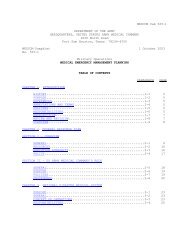(MCD) Guidelines
(MCD) Guidelines
(MCD) Guidelines
You also want an ePaper? Increase the reach of your titles
YUMPU automatically turns print PDFs into web optimized ePapers that Google loves.
<strong>Guidelines</strong> for Military Mass Casualty Decontamination Operations<br />
During a Domestic HAZMAT/Weapon of Mass Destruction Incident<br />
Table 6: Principals of Mass Casualty Decontamination.<br />
Identify and understand the<br />
hazard(s) and operating<br />
conditions of the incident.<br />
Conduct and coordinate<br />
both decontamination and<br />
medical triage.<br />
Disrobing may be a critical<br />
step and can remove the<br />
majority of physical contamination<br />
(depends on<br />
casualty state of dress).<br />
Use high-volume, low<br />
pressure lukewarm water<br />
showers, with liquid soap if<br />
available, for up to 5<br />
minutes or as indicated by<br />
post-decontamination<br />
monitoring.<br />
Monitor decontamination<br />
effectiveness; use random<br />
sampling of casualties<br />
before transportation to<br />
medical treatment facility.<br />
Principals of Mass Casualty Decontamination<br />
Knowing what agent that contaminated the casualties can 1) change the<br />
level of IPE/PPE to be worn by responders during response operations,<br />
2) determine <strong>MCD</strong> decontamination processes to be used, and 3)<br />
modify the <strong>MCD</strong> processes as appropriate as the incident response<br />
progresses. Knowing hazards such as slip, trip, falls, overhead hazards,<br />
and heat/cold hazards ensures that responding personnel and<br />
casualties are safe. Safety is a large concern. (Sections 8.1.2 and 8.1.5)<br />
Triage is a prioritization system to allow responders to provide the<br />
necessary care to as many people as possible. Decontamination triage<br />
should not be confused with medical triage. Decontamination triage is<br />
performed to determine who should be washed off first, while medical<br />
triage is performed to determine who should receive medical treatment<br />
first. (Section 8.1.9)<br />
Disrobing is a fast and easy decontamination process that can remove<br />
most of the external contaminant, during most times of the year.<br />
Summer months in warmer climates will result in a lower removal<br />
percentage by disrobing, due to a greater percentage of exposed skin.<br />
(Section 7.3.1)<br />
High volume and low pressure water aids in the removal of any<br />
contamination. High volume ensures there is enough water to<br />
completely douse the casualty. Low pressure flow minimizes potential<br />
damage to the skin that could allow the contaminant to penetrate the<br />
skin faster. Water should be lukewarm so that the skin’s pores are less<br />
likely to open. Soap or other decontamination solutions can be added<br />
into a decontamination process to ensure more thorough removal of the<br />
contaminant. (Sections 8.2.1 – 8.2.5)<br />
Verify casualties have been decontaminated with appropriate detectors<br />
to verify that contaminants were successfully removed. If an appropriate<br />
detector is not available, visually observe the casualty for indicators that<br />
contamination removal was unsuccessful or wait for appropriate<br />
detector. (Section 8.1.11)<br />
During decontamination operations, also consider the containment, environmental<br />
run-off and monitoring, contamination and recontamination avoidance, and site<br />
cross-contamination prevention. However, the key <strong>MCD</strong> principles described in<br />
Table 6 apply regardless of the size and complexity of the incident.<br />
7.3 Methods of Decontamination<br />
Mass casualty decontamination can be accomplished predominately by physical<br />
removal and neutralization. 15,23 Preventive methods, such as the use of disposable<br />
protective clothing and equipment, reduce the risk of cross-contamination. 23<br />
Consider the agent’s solubility and reactivity with water when selecting the best<br />
method to decontaminate casualties. 23 Decontamination methods are described in<br />
detail in Field Manuals 3-11.5 and 4-02.7. 13,15<br />
28 Original



